John J. Young Jr.
has served since 2007 as undersecretary of defense for acquisition, technology, and logistics. In a Nov. 20, 2008 meeting with the Defense Writers Group in Washington, D.C., he offered a critical view of the Air Force’s F-22 fighter and other programs. What follows are excerpts of his remarks.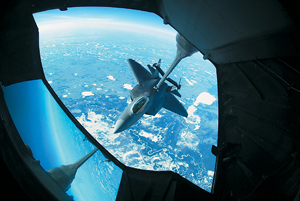 |
An F-22 takes on fuel from a KC-10 over Alaska. (USAF photo by A1C Jonathan Snyder) |
Raptor Problems
Congress has added money for advanced procurement to buy more [F-22] airplanes. And I don’t think the debate’s informed by all [the] facts. The recent mission capable data for Fiscal 2008 [show] F-22s had a mission capable rate somewhere in the 62 percent range. I think that’s troubling.
Follow-on operation tests in 2007 raised operational suitability issues and noted that the airplane still does not meet most of its KPPs—key performance parameters. It meets some, but not all. The trend in those operational tests—there was an IOT&E, a follow-on test, I think in 2004, and a follow-on test in 2007—the trend is actually negative.
The maintenance-man-hours per flying hour have increased through those tests. The last one was a substantial increase. The airplane is proving very expensive to operate, not seeing the mission capable rates we expected. And it’s complex to maintain.
$8.3 Billion F-22 Bill
The Air Force had planned and expected to have kind of a two-tiered [F-22] structure, where some of the earlier jets were not fully capable jets—not to the Block 35 or increment 3.2 configuration, which provides important capabilities. I think something like 100 jets [were to] be lesser models. So one thing that’s in the budget … is to bring more of that fleet, most of that fleet, to a common, high-end, capable configuration, but the cost of that is $6.3 billion of R&D. This is in a platform we’ve already developed. We’re going to spend six billion more of R&D to engineer the 3.2 upgrade for the software and the changes in the jet, and then about $2 billion to modify the jets. That’s $8 billion more, and $8 billion I think needs to be spent in order to make sure the 183 airplanes we have will be highly capable fighters. Those discussions need to be had before I think you talk about buying more jets.
“Discipline” Needed on F-22
That’s really a requirements and a capability discussion that the Air Force and OSD have to have. There are lots of studies, … but I think people are executing a fair amount of discipline and just making sure the airplanes that we’ve already made a substantial investment [in] are capable, and I’m not so sure there still isn’t more work to do there. … The maintenance on the airplane is too high. They’re struggling with some of the [low-observable maintenance] and other issues, and there’s clearly work that needs to be done there to make that airplane both capable and affordable to operate.
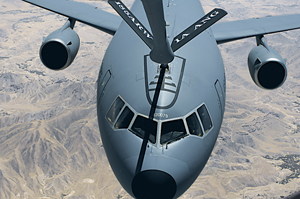 |
A KC-10 moves into refueling position under a KC-135 during a mission over Afghanistan. |
What Is the F-22 Requirement
I don’t know the exact state. … There is an answer to that question. I am not ducking that. I just don’t know the answer to that. I can tell you … the deputy [Deputy Defense Secretary Gordon England] had the discussion with the Air Force about this. He said to Air Force, ‘Do you or don’t you require more F-22s?’ And they couldn’t answer that question. They said, ‘We are reviewing this issue.’ [It was] about two weeks ago [early November]. … So the fact that they couldn’t answer the question then, I think, is troubling. … Gen. [Norton A.] Schwartz [USAF Chief of Staff] wasn’t there. I don’t want to talk about who was there. ‘Air Force leadership’—whoever wanted to come to the meeting. Whoever the Air Force deemed appropriate to meet with the deputy. The deputy said, ‘Where is the Air Force on this?’ And the Air Force said, ‘We are looking at this so that we can have a recommendation.’ And the deputy said, ‘Well, the transition team is going to show up shortly and you need to have a recommendation.’ But the other thing to be clear: The building is filled with requirements that are not met, that aren’t funded, that aren’t addressed.
F-35 Fighter Status
I think the [recent Defense Acquisition Board review] was a successful and productive discussion on the Joint Strike Fighter. I certainly didn’t see anything in the DAB that would say we shouldn’t approve it. I’m anxious for the program office in Lockheed to agree on the negotiated prices, but right now the good news is they seem to be on or below the pricing curve, which is really a positive curve for the program as a whole and for the warfighter and the taxpayer. I’ve asked them to give me a good sense of how those negotiations are going to come out, but I can see approving at least the [conventional takeoff and landing type, the Air Force variant].
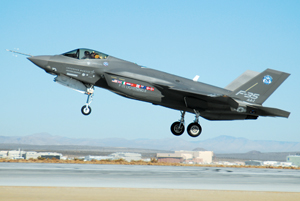 |
An F-35 Lightning II test aircraft lands at Edwards AFB, Calif. |
Tanker Priority
There’s a very big vacuum right now because of the transition process, so people are sometimes filling it poorly, but … the requirements will get settled, the new Administration will get in place, they’ll be briefed on those requirements, then they’ll make a decision about all the relative priorities they have, advised by the military’s view of those priorities. I think one of those on the list will have to be tanker. What do we or don’t we do about tanker, relative to all our other priorities
Tanker Requirements Scrub
Some set of [tanker] requirements have to be deemed to be mandatory, … and then the rest … can be things we’re interested in, nice features; they can be whatever. We cannot have 800 tradable requirements again. … Secretary [of Defense Robert M.] Gates has been very clear about this. The Air Force needs to think hard about getting down to a minimum set of requirements and features. Then, probably, … we need to then evaluate whoever bids, as to whether they are technically acceptable or not, and then have a second round where we say, ‘OK, you’re technically acceptable; give me your best price,’ and the best price is going to win because then I’ll get the best deal for the taxpayer and I’ll get my minimum set of requirements met. … I can tell you for sure I think that is a path he and I and others will recommend to the new Administration.
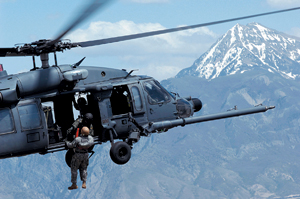 |
A USAF HH-60 hovers during a combat search and rescue training exercise. |
CSAR Aircraft Optional
You start with the premise ‘CSAR-X community’ is in ‘desperate need.’ Well, we have a lot of assets that can be used in rescue missions with planning, so I don’t necessarily just automatically rubber stamp the CSAR-X requirement. I don’t know that that community has to have its own set of assets for the occasional rescue mission. We have new things coming on line like V-22s and other things that can be pressed into service. When we do our rescue mission we’re going to do a come-as-you-are operation anyway, unless all the CSAR assets are pre-positioned for that.
CSAR-X Program Problems
I can’t deny that CSAR-X has a couple of the problems that were in [the tanker program], and I think they should have been caught sooner. It is to the credit of the team that they listened to. One team that banged the drum on this was the OSD independent team. They went in and said CSAR-X is not in a good position to be awarded right now. I just wish we’d all found that sooner, because we were marching up, as you know, to the potential for a November/December [2008] award. To postpone this in October is not optimal.
USAF and Military Space
I think space is probably high on [the list of problem sectors]. … I have expressed and I would continue to express concerns about the idea that you can put all space and all milestone decisions in the Air Force. That recommendation creates a complication where you have a person who is the undersecretary in the Air Force and is, therefore, somewhat … a champion for the Air Force, also having to make hard decisions about the children in his family, i.e. the space programs. … Where we had a space technology we wanted to develop, I found the persons who notionally would be in charge of space as the executive agent wanted to kill that technology program because they thought it threatened their multibillion-dollar space acquisition program. You can’t have that kind of behavior in the enterprise. That’s why you have to have purple oversight, detached oversight, and some neutral view of this, and that’s why I believe space milestone decisions have got to stay with AT&L.
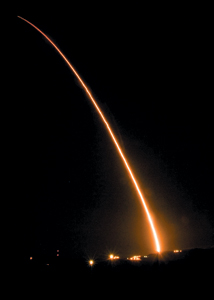 |
A Minuteman ICBM launch at Vandenberg AFB, Calif. |
“Fixing” the Air Force
There are many things that are managed very well every day in the Air Force. But to the extent we’ve had … problems, I, like you, have tried to look for the root cause in that. I can’t tell you I have it exactly. … I’ve had members of my team tell me there’s still some of the practices and culture that evolved during Darleen Druyan’s tenure. … And I think we do have to keep working some elements of the Air Force culture. … I do think there are lingering elements of culture that do have to be changed, and I think the combination of Air Force leadership and some of the OSD work on best practices, which has been well received by the Air Force, will not only help but I think will fix many of the issues there.
